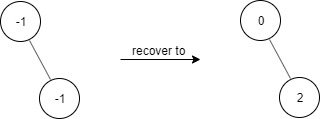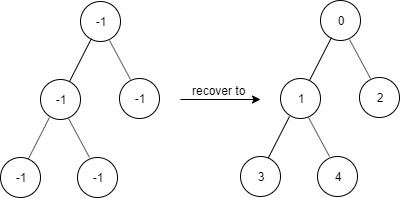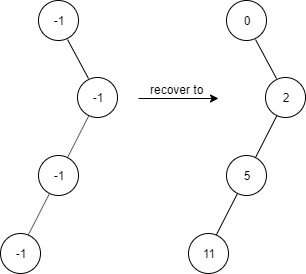- {x}
- Reconstruct a 2-Row Binary Matrix
- Number of Closed Islands
- Maximum Score Words Formed by Letters
- Encode Number
- Smallest Common Region
- Synonymous Sentences
- Handshakes That Don't Cross
- Shift 2D Grid
- Find Elements in a Contaminated Binary Tree
- Greatest Sum Divisible by Three
- Minimum Moves to Move a Box to Their Target Location
- Page Recommendations
- Print Immutable Linked List in Reverse
- Minimum Time Visiting All Points
- Count Servers that Communicate
- Search Suggestions System
- Number of Ways to Stay in the Same Place After Some Steps
- Read More...

Find Elements in a Contaminated Binary Tree
Given a binary tree with the following rules:
root.val == 0- For any
treeNode:- If
treeNode.valhas a valuexandtreeNode.left != null, thentreeNode.left.val == 2 * x + 1 - If
treeNode.valhas a valuexandtreeNode.right != null, thentreeNode.right.val == 2 * x + 2
- If
Now the binary tree is contaminated, which means all treeNode.val have been changed to -1.
Implement the FindElements class:
FindElements(TreeNode* root)Initializes the object with a contaminated binary tree and recovers it.bool find(int target)Returnstrueif thetargetvalue exists in the recovered binary tree.
Example 1:

Input ["FindElements","find","find"] [[[-1,null,-1]],[1],[2]] Output [null,false,true] Explanation FindElements findElements = new FindElements([-1,null,-1]); findElements.find(1); // return False findElements.find(2); // return True
Example 2:

Input ["FindElements","find","find","find"] [[[-1,-1,-1,-1,-1]],[1],[3],[5]] Output [null,true,true,false] Explanation FindElements findElements = new FindElements([-1,-1,-1,-1,-1]); findElements.find(1); // return True findElements.find(3); // return True findElements.find(5); // return False
Example 3:

Input ["FindElements","find","find","find","find"] [[[-1,null,-1,-1,null,-1]],[2],[3],[4],[5]] Output [null,true,false,false,true] Explanation FindElements findElements = new FindElements([-1,null,-1,-1,null,-1]); findElements.find(2); // return True findElements.find(3); // return False findElements.find(4); // return False findElements.find(5); // return True
Constraints:
TreeNode.val == -1- The height of the binary tree is less than or equal to
20 - The total number of nodes is between
[1, 104] - Total calls of
find()is between[1, 104] 0 <= target <= 106
Solution Explanation: 1261. Find Elements in a Contaminated Binary Tree
This problem involves recovering a contaminated binary tree and efficiently checking for the existence of a target value. The tree follows specific rules for node values: the root has value 0, and for any node with value x, its left child has value 2x + 1 and its right child has value 2x + 2. All node values are initially set to -1.
Approach: DFS and Hash Set
The most efficient approach combines Depth-First Search (DFS) with a hash set (or similar data structure like a set in Python or Java).
-
Initialization (
FindElementsconstructor):- We perform a DFS traversal of the binary tree, starting from the root.
- During the traversal, we reconstruct the original values of the nodes using the given rules. The root is set to 0. If a node has value
x, its left child is assigned2x + 1, and its right child is assigned2x + 2. - Simultaneously, we add each node's restored value to a hash set (
self.sin Python,sin Java/C++/Go/TypeScript). This hash set acts as an index for efficient lookup.
-
Search (
findmethod):- To check if a
targetvalue exists, we simply look up thetargetin the hash set. This operation has a time complexity of O(1) on average due to the constant-time nature of hash table lookups.
- To check if a
Time and Space Complexity
-
Time Complexity:
- Initialization: The DFS traversal takes O(N) time, where N is the number of nodes in the binary tree. Each node is visited once.
- Search: Checking if a target exists in the hash set takes O(1) average time.
- Overall: The overall time complexity is dominated by the initialization, resulting in O(N).
-
Space Complexity:
- The hash set stores all the node values, which is at most N. Therefore, the space complexity is O(N).
Code Examples (Multiple Languages)
The provided code in Python, Java, C++, Go, and TypeScript all implement this approach. The core logic remains consistent: a DFS for reconstruction and a hash set for efficient searching. The specifics of hash set implementation vary slightly between languages. Each code snippet demonstrates this solution effectively.
Alternative Approaches
While this approach is optimal in terms of time complexity, alternative approaches exist (but are less efficient):
- Level-order traversal (BFS): Similar to DFS, BFS can be used to recover the node values and store them in a hash set. This would still have O(N) time and space complexity.
- Recursive search without hash set: A recursive search function could be implemented without a hash set to check for the target. However, this would have a much worse time complexity, potentially O(N) for each
findoperation in the worst case.
The DFS with a hash set method is superior because of its efficient O(1) average-case search time after the initial O(N) initialization.